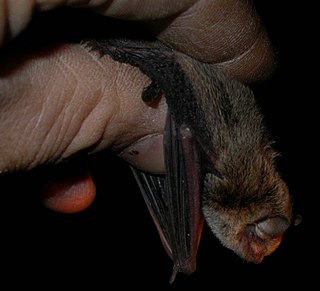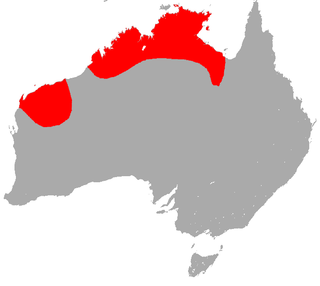
Gould's long-eared bat is a microbat found in southern regions of Australia. It occurs in eastern Australia, from Queensland to Victoria, and in a smaller isolated range in the south-west of Western Australia.

The chocolate wattled bat, species Chalinolobus morio, is a bat in the family Vespertilionidae. It is found only in Australia, including the island Tasmania, and widespread in southern regions. It is known to reside from sea level to at least 1,570 metres (5,150 ft) in Victoria.

Rüppell's or the greater broad-nosed bat is a species of vespertilionid microbat found in eastern Australia.

The northern broad-nosed bat is a species of the vespertilionid family of microbats. It can be found in northern Australia, Timor-Leste, and Papua New Guinea.

Nyctophilus arnhemensis, known as the northern or Arnhem long-eared bat, is a species of Chiroptera (bats) native to northern regions of Australia. The distribution range is from north-western Queensland to northern Western Australia.

Nyctophilus geoffroyi is a vespertilionid bat, a flying nocturnal mammal found in Australia, The species is relatively common. They have been referred to as the lesser long-eared bat.

The pygmy long-eared bat is a vesper bat, found in the north of the Australian continent. An insectivorous flying hunter, they are one of the tiniest mammals in Australia, weighing only a few grams and one or two inches long.
The western false pipistrelle, species Falsistrellus mackenziei, is a vespertilionid bat that occurs in Southwest Australia. The population is declining due to loss of its habitat, old growth in tall eucalypt forest which has largely been clear felled for tree plantations, wheat cultivation and urbanisation. Although it is one of the largest Australian bats of the family, the species was not recorded or described until the early 1960s. A darkly colored bat with reddish brown fur and prominent ears, they fly rapidly around the upper canopy of trees in pursuit of flying insects.
The inland forest bat is a vesper bat that occurs in central and arid regions in Australia. They were first described in 1987, published in a review of poorly surveyed microbat populations. A tiny flying mammal, whose body is around twelve millimetres (½ inch) long, that occupies small cavities in trees and buildings while roosting. The nocturnal activity is foraging for insects, typically moths.

Vespadelus is a genus of Australian bats in the family Vespertilionidae.
The large forest bat is a common vesper bat found in southeast Australia, Tasmania, and Lord Howe Island.
The yellow-lipped cave bat is a vesper bat that only occurs in the Kimberley region of northwest Australia. The bat was first captured at Tunnel Creek in 1958 and a description published nearly twenty years later. Aside from observations of their physical characteristics, a preference for caves, and hunting insects over streams, little is known of the species.
Finlayson's cave bat is a species of vesper bat found only in Australia.
The southern forest bat is a vesper bat found in Australia.

The little forest bat is a species of vesper bat in the family Vespertilionidae. It is found only in south-eastern Australia, including Tasmania. It is a tiny bat often weighing less than 4 g (0.14 oz). It is sometimes referred to as Australia's smallest mammal, although the Northern or Koopmans Pipistrelle, Pipistrellus westralis, is possibly smaller, weighing on average around 3 g (0.11 oz). It is the smallest bat in Tasmania

The common sheathtail bat, is a bat in the family Emballonuridae, occurring in northern Australia.

The orange leaf-nosed bat is a bat in the family Hipposideridae. It is the only living species in the genus Rhinonicteris which is endemic to Australia, occurring in the far north and north-west of the continent. They roost in caves, eat moths, and are sensitive to human intrusion.

Nyctophilus major, referred to as a western long-eared bat, is a species found in forests and woodlands of Southwest Australia.
Ozimops lumsdenae is a species of molossid bat found in Australia, the largest of the genus Ozimops.
Ozimops halli, also referred to as the Cape York free-tailed bat, is a species of molossid bat found at the Cape York Peninsula in Australia.










